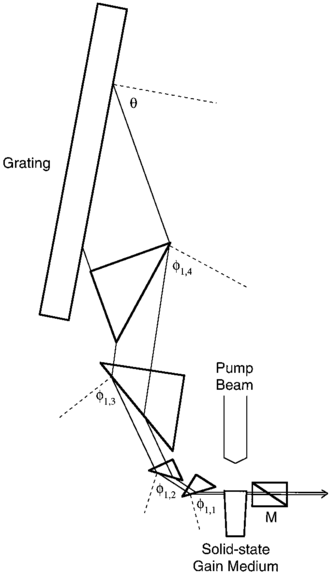Organic laser
Organic lasers use an organic (carbon based) material as the gain medium. The first organic laser was the liquid dye laser.[1][2] These lasers use laser dye solutions as their gain media.

Organic lasers are inherently tunable and when configured as optimized multiple-prism grating laser oscillators can yield efficient single-transverse mode, and single-longitudinal-mode, emission with laser linewidths as narrow as 350 MHz (approximately 0.0004 nm at a wavelength of 590 nm), in the high-power pulsed regime.[3]
Solid-state dye lasers

Solid-state dye lasers are organic tunable lasers that use a variety of organic gain media, such as laser dye-doped polymers (DDP),[5] laser dye-doped ormosil (DDO),[6] and laser dye-doped polymer-nanoparticle (DDPN) matrices.[7]
DDO and DDPN gain media are subsets of a larger class of organic-inorganic hybrid materials used as laser matrices.[8][9]
Organic semiconductor laser
Other types of solid-state organic lasers include the organic semiconductor lasers that use conjugated polymers as gain media.[10][11][12][13] These semiconductor materials can also be configured as "neat films."[14]
Coherent emission, characterized via high-visibility double-slit interferograms (V ~ 0.9) and near diffraction-limited beam divergence, has been reported from electrically-pumped coumarin dye-doped tandem OLED devices.[15]
Distributed feedback laser
Organic lasers are also available in distributed feedback configurations[16][17] and distributed feedback waveguides.[18]
See also
- Nanoparticle
- Organic photonics
- Organic semiconductors
- Solid-state dye lasers
References
- Sorokin, P. P.; Lankard, J. R. (1966). "Stimulated Emission Observed from an Organic Dye, Chloro-aluminum Phthalocyanine". IBM Journal of Research and Development. IBM. 10 (2): 162–163. doi:10.1147/rd.102.0162. ISSN 0018-8646.
- Schäfer, Fritz P.; Schmidt, Werner; Volze, Jürgen (1966-10-15). "Organic dye solution laser". Applied Physics Letters. AIP Publishing. 9 (8): 306–309. doi:10.1063/1.1754762. ISSN 0003-6951.
- Duarte, Francisco J. (1999-10-20). "Multiple-prism grating solid-state dye laser oscillator: optimized architecture". Applied Optics. The Optical Society. 38 (30): 6347-6349. doi:10.1364/ao.38.006347. ISSN 0003-6935.
- Duarte, Francisco J.; Taylor, Travis S.; Costela, Angel; Garcia-Moreno, Inmaculada; Sastre, Roberto (1998-06-20). "Long-pulse narrow-linewidth dispersive solid-state dye-laser oscillator". Applied Optics. The Optical Society. 37 (18): 3987–3989. doi:10.1364/ao.37.003987. ISSN 0003-6935.
- Soffer, B. H.; McFarland, B. B. (1967-05-15). "Continuously tunable narrow-band organic dye lasers". Applied Physics Letters. AIP Publishing. 10 (10): 266–267. doi:10.1063/1.1754804. ISSN 0003-6951.
- B. S. Dunn, J. D. Mackenzie, J. I. Zink, and O. M. Stafsudd, Solid-state tunable lasers based on dye-doped sol-gel materials, Proc. SPIE 1328, 174-182 (1990).
- Duarte, F. J.; James, R. O. (2003-11-01). "Tunable solid-state lasers incorporating dye-doped, polymer– nanoparticle gain media". Optics Letters. The Optical Society. 28 (21): 2088–2090. doi:10.1364/ol.28.002088. ISSN 0146-9592.
- A. Costela, I. Garcia-Moreno, R. Sastre, Solid-state dye lasers, in Tunable Laser Applications, 2nd Edition, F. J. Duarte, Ed. (CRC, New York, 2009) Chapter 3.
- Costela, A.; Cerdán, L.; García-Moreno, I. (2013). "Solid state dye lasers with scattering feedback". Progress in Quantum Electronics. Elsevier BV. 37 (6): 348–382. doi:10.1016/j.pquantelec.2013.10.001. ISSN 0079-6727.
- Samuel, I. D. W.; Turnbull, G. A. (2007). "Organic Semiconductor Lasers". Chemical Reviews. American Chemical Society (ACS). 107 (4): 1272–1295. doi:10.1021/cr050152i. ISSN 0009-2665.
- C. Karnutsch, Low Threshold Organic Thin Film Laser Devices (Cuvillier, Göttingen, 2007).
- Kuehne, Alexander J. C.; Gather, Malte C. (2016-08-08). "Organic Lasers: Recent Developments on Materials, Device Geometries, and Fabrication Techniques". Chemical Reviews. American Chemical Society (ACS). 116 (21): 12823–12864. doi:10.1021/acs.chemrev.6b00172. hdl:10023/11411. ISSN 0009-2665.
- Patil, N. (2006). "Optical Pumping in Polymer Lasers: Advances and Challenges". Optics and Photonics News. Optical Society of America (OSA). 17 (5): 37–41. doi:10.1364/OPN.17.5.000037. ISSN 1047-6938.
- Bansal, A.K.; Penzkofer, A. (2008). "Linear and nonlinear optical spectroscopic characterisation of triphenylamine and 1,2,3-tris(3-methylphenylphenylamino)benzene". Chemical Physics. Elsevier BV. 352 (1–3): 48–56. doi:10.1016/j.chemphys.2008.05.006. ISSN 0301-0104.
- Duarte, F. J.; Liao, L. S.; Vaeth, K. M. (2005-11-15). "Coherence characteristics of electrically excited tandem organic light-emitting diodes". Optics Letters. The Optical Society. 30 (22): 3072-3074. doi:10.1364/ol.30.003072. ISSN 0146-9592.
- Wadsworth, W.J.; McKinnie, I.T.; Woolhouse, A.D.; Haskell, T.G. (1999-08-01). "Efficient distributed feedback solid state dye laser with a dynamic grating". Applied Physics B: Lasers and Optics. Springer Science and Business Media LLC. 69 (2): 163–165. doi:10.1007/s003400050791. ISSN 0946-2171.
- Zhu, Xiao-Lei; Lam, Sio-Kuan; Lo, Dennis (2000-06-20). "Distributed-feedback dye-doped solgel silica lasers". Applied Optics. The Optical Society. 39 (18): 3104–3107. doi:10.1364/ao.39.003104. ISSN 0003-6935.
- Oki, Yuji; Miyamoto, Shinichi; Tanaka, Masamitsu; Zuo, Duluo; Maeda, Mitsuo (2002). "Long lifetime and high repetition rate operation from distributed feedback plastic waveguided dye lasers". Optics Communications. Elsevier BV. 214 (1–6): 277–283. doi:10.1016/s0030-4018(02)02125-9. ISSN 0030-4018.